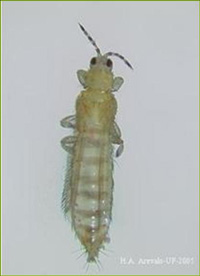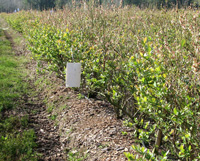Thrips Monitoring in Florida Blueberries (Part 2 - Year 2007)
Project description and objectives:
Flower thrips are very small insects (~1 mm in length) with yellowish to orange coloration. They can be distinguished from other insect orders by their fringed  wings. They have a short life cycle that can occur in 18 to 22 days under ideal conditions. Thrips progress though two active feeding larval instars and two inactive instars (often called pupae) before becoming adults.
wings. They have a short life cycle that can occur in 18 to 22 days under ideal conditions. Thrips progress though two active feeding larval instars and two inactive instars (often called pupae) before becoming adults.
Flower thrips damage flowers in two ways. Larvae and adults feed on all parts of the flowers including ovaries, styles, petals, and developing fruit. This feeding damage can reduce the quality and quantity of fruit produced. Females also cause damage to fruit when they lay their eggs inside flower tissues. The newly hatched larvae bore holes in flower tissue when they emerge.
In Florida, several southern highbush blueberry varieties are grown together on the same farm. These varieties differ in fruit and flower characteristics and in the timing and length of flowering period, which may lead to differences in thrips numbers and thrips injury. To examine this possibility, thrips numbers and fruit injury data were collected for four different varieties on two commercial farms and compared among varieties.
Project activities:
Samples were taken from two commercial farms, 1 and 2. Traps were placed in the plots on January 25 and evaluated once a week for 7 weeks. On each farm, the four most popular varieties: Emerald, Jewel, Millennium, and Windsor were divided into three  treatments. Three traps were placed in each treatment: A, B, and C. If the number of thrips per trap exceeded 200 in treatment A or 100 in treatment B, SpinTor® was applied at the recommended rate. Treatment C was an untreated control. Sticky traps were replaced weekly and five flowers from the plant closest to the trap were also sampled.
treatments. Three traps were placed in each treatment: A, B, and C. If the number of thrips per trap exceeded 200 in treatment A or 100 in treatment B, SpinTor® was applied at the recommended rate. Treatment C was an untreated control. Sticky traps were replaced weekly and five flowers from the plant closest to the trap were also sampled.
All samples were sent to the Small Fruit and Vegetable IPM Laboratory at the University of Florida in Gainesville. There, the flowers were dissected and immature and adult thrips were counted and preserved in 1 dram glass vials in 70% ethanol. The number of thrips per sticky trap was counted under a tabletop magnifying lens. At harvest time, 25 berries from four plants adjacent to each sticky trap were examined for thrips injury and marketability.
The data were transformed as necessary to fit the assumptions and compared among treatments and varieties at each location using an ANOVA test in SAS. Means were separated using an appropriate means separation test. This was done for thrips per sticky trap, thrips larvae per flower, thrips adults per flower, all injured fruit, and unmarketable fruit.
Project accomplishments:
Emerald had significantly higher numbers of thrips per sticky trap than the other varieties on both farms. On farm 1, Millennia had significantly fewer thrips per trap than Windsor, but on farm 2, Windsor had significantly fewer thrips per trap than both Jewel and Millennia.
On farm 1, there were significantly more adult thrips per flower collected from the Emerald variety. Thrips larvae per flower on farm 1 and both adults  and larval thrips per flower on farm 2 varied greatly among the weeks.
and larval thrips per flower on farm 2 varied greatly among the weeks.
There were no significant differences in the number of injured or unmarketable fruits among varieties. Very few fruits were injured to the point of being unmarketable.
There were significantly more thrips per trap collected from the Emerald variety on both farms and significantly more thrips adults per flower were collected from the Emerald variety on farm 1. Emerald flowers earlier than the other varieties and has a longer flowering period, which may explain why there were more thrips per trap collected from this variety. There were no significant differences in fruit injury among varieties indicating that thrips numbers did not reach damaging levels in the flowers this spring.
Farm 1 had much higher thrips numbers than farm 2 this spring. This may be due, in part, to the planting scheme of the farms. Farm 1 has large areas of the same variety with single rows of another variety interspersed. In contrast, farm 2 has a few rows of one variety alternating with a few rows of another variety in a regular fashion. The large area of Emerald flowering before the other varieties may have attracted a large number of thrips to that part of farm 1, resulting in fewer numbers elsewhere. However, the regularly structured setup of farm 2 may have caused the thrips to be evenly distributed throughout the farm.
Our findings indicate that blueberry varieties flower at different times and for varying length of times, which may influence thrips population in southern blueberry plantings.
Click here to see the report on this project (pdf 42KB)
Project leaders:
Dr. Gary England, Sumter County Extension
Dr. Oscar Liburd, Associate
Professor, Entomology
Elena Rhodes, Entomology
For more information on IPM of Fruits and Vegetables: http://entomology.ifas.ufl.edu/liburd/fruitnvegipm/